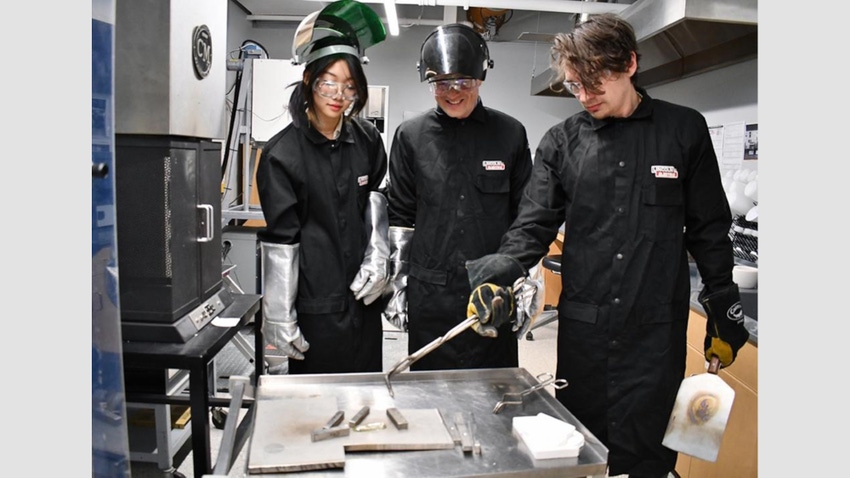New LionGlass is 10x Stronger with Half the Carbon Footprint
Researchers are “decoding the glass genome” to better predict how glass behaves and testing the limits of LionGlass for real-world applications, including packaging.

At a Glance
- Revolutionary new glass composition promises 10x strength and half the carbon footprint of traditional soda-lime silica glass
- LionGlass aims to lower industry emissions by reducing melting temperatures, improving glass sustainability
- LionGlass boasts improved damage resistance, boosting packaging line performance and allowing container lightweighting
John Mauro, Dorothy Pate Enright Professor of Materials Science and Engineering at Penn State, and a team of research students are about to shatter the commodity glass ceiling: After decades of soda-lime silica glass dominating the glass market, Mauro has filed several patents for a new family of glass compositions called LionGlass.
Prior to his work at Penn State, Mauro worked for Corning for 18 years developing new commercial glass compositions, including Gorilla Glass commonly used in cell phones. But qualified research students were hard to come by, and many of the glass science professors that Corning relied on were retiring.
“Penn State was a very important talent pipeline for us,” he says. “When we found out that the glass science professor at Penn State was planning to retire, people at Corning were concerned because we had hired every single one of his Ph.D. graduates for the past decade or so.”
In a bold move, Mauro quit his job at Corning to take over the vacant position of glass science professor at Penn State and has been there ever since. In addition to establishing the largest academic glass research group in the United States, he has sent a few of his students to work at Corning.
Reduced carbon footprint, increased strength.
For Mauro, reducing the glass industry’s carbon footprint (soda-lime silica glass accounts for approximately 95% of the world’s glass volume) was the motivation behind developing LionGlass. Soda-lime silica glass uses carbonate batch materials, which release carbon dioxide when melted, accounting for 20% to 30% of the product’s carbon footprint. The remaining 70% to 80% is a result of energy consumption due to the high temperatures involved in melting glass — around 1,450 degrees Celsius.
“To address this problem, we needed to develop a completely new family of glass compositions that would both dramatically lower the temperature required for melting, thereby lowering the energy that’s needed, and also eliminate the need for carbonate batch materials,” Mauro says.
The resulting LionGlass is a family of glasses called zinc aluminosilicophosphate that do not use carbonates and lower the melting temperature by about 400 to 500°C. Although improving the mechanical properties of glass was not one of Mauro’s original intents, LionGlass has dramatically improved strength and ten times the damage resistance compared to standard soda-lime silica glass.
“We can improve the mechanical performance of glass products, and we can also use that improved performance as a mechanism for light-weighting glass products, which has been another longstanding challenge in the commodity glass industry: If a standard glass bottle or jar uses half the material it will have half the carbon footprint; however, the mechanical performance will be sacrificed, causing it to break more easily,” Mauro explains.
Another unintended advantage of LionGlass is its improved ultraviolet absorption, making it suitable for products that could degrade due to ultraviolet radiation, such as food, beverages, and cosmetics. Because LionGlass is designed as a replacement for soda-lime silica rather than borosilicate glass, it does not have the chemical-corrosion or thermal-shock resistance needed for pharmaceutical packaging applications.
The pride of Penn State.
Mauro shares that LionGlass was named after Penn State University’s mascot, the Nittany Lion, an eastern mountain lion that once roamed Mount Nittany, which overlooks the university. The name “Mount Nittany” is believed to be a Native American term meaning “the one mountain that stands out.” Mauro admits the name is also a nod to his previous work in Gorilla Glass and the fact that it was named after an animal.
Mauro is currently in the process of forming partnerships with glass companies and their customers to take the next steps for industrial scale-up and commercialization in different markets. He was unable to divulge the name of these companies due to non-disclosure agreements.
His students are actively involved in testing LionGlass and are listed as co-inventors on the patents.
“One of the things we pride ourselves on at Penn State is giving graduate and undergraduate students active research experience, and they’ve become a key part of this research,” he says.
About the Author(s)
You May Also Like




